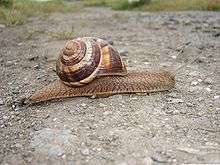Helix lucorum
| Helix lucorum | |
|---|---|
 | |
| live specimen of Helix lucorum | |
| NE[1] | |
| Scientific classification | |
| Kingdom: | Animalia |
| Phylum: | Mollusca |
| Class: | Gastropoda |
| (unranked): | clade Heterobranchia clade Euthyneura |
| Superfamily: | Helicoidea |
| Family: | Helicidae |
| Subfamily: | Helicinae |
| Tribe: | Helicini |
| Genus: | Helix |
| Subgenus: | Helix |
| Species: | H. lucorum |
| Binomial name | |
| Helix lucorum Linnaeus, 1758 | |
| Synonyms[2] | |
| |
Helix lucorum is a species of large, edible, air-breathing land snail or escargot, a terrestrial pulmonate gastropod mollusk in the family Helicidae, the typical snails.
Description

The shell of Helix lucorum
Adult snails weight about 20-25 g.[3]
The width of the shell is 35-60.[4] The height of the shell is 25–45 mm.[4]
This species of snail makes and uses love darts.
Distribution
The native distribution is Eastern mediaterranean and Asia Minor.[5]
- Eastern Europe - East region of Black sea: Georgia[6] and Ukraine[7]
- Southern Europe - Albania, Bosnia and Herzegovina, Bulgaria, Croatia, Hungary, Italy, Macedonia, Romania, Sardinia, Yugoslavia, Turkey
- Central Europe: Czech Republic (since 2009, introduced, as of 2011 there is the only locality in Prague-Žižkov)[4][5] and Slovakia (since 2013, introduced, as of 2014 there is the only locality in Bratislava)[8]
- Western Europe: France (introduced)
- Asia: Israel[9]
Ecology
The size of the egg is 4.4 mm.[10] 2–3 months old juvenile snails weight 0.5-0.9 g.[3]
Human use
Helix lucorum is used in cuisine as escargots.
|
Helix lucorum served as escargots | |
| Nutritional value per 100 g (3.5 oz) | |
|---|---|
| Energy | 95 kcal (400 kJ) |
|
0 g | |
| Sugars | 0 g |
| Dietary fiber | 0 g |
|
1.59 g | |
| Saturated | 0 g |
| Trans | 0 g |
|
19.05 g | |
| Vitamins | |
| Vitamin A equiv. |
(0%) 0 μg |
| Vitamin C |
(0%) 0 mg |
| Minerals | |
| Calcium |
(16%) 159 mg |
| Iron |
(18%) 2.29 mg |
| Sodium |
(7%) 103 mg |
| Other constituents | |
| Cholesterol | 206 mg |
|
| |
| |
| Percentages are roughly approximated using US recommendations for adults. | |
References
- ↑ IUCN 2008. 2008 IUCN Red List of Threatened Species. <www.iucnredlist.org>. Downloaded on 16 April 2009.
- ↑ http://www.fauna-eu.org/cdm_dataportal/taxon/24610e8f-4bba-40a1-a1c3-6d46ff884803#page-toc cited 3 December 2015
- 1 2 Danilova A.B. & Grinkevich L. N. (2012). "Failure of Long-Term Memory Formation in Juvenile Snails Is Determined by Acetylation Status of Histone H3 and Can Be Improved by NaB Treatment". PLoS ONE 7(7): e41828. doi:10.1371/journal.pone.0041828.
- 1 2 3 (Czech) Horsák M., Juřičková L., Beran L., Čejka T. & Dvořák L. (2010). "Komentovaný seznam měkkýšů zjištěných ve volné přírodě České a Slovenské republiky. [Annotated list of mollusc species recorded outdoors in the Czech and Slovak Republics]". Malacologica Bohemoslovaca, Suppl. 1: 1-37. PDF.
- 1 2 Peltanová A., Petrusek A., Kment P. & Juřičková L. (2011). "A fast snail's pace: colonization of Central Europe by Mediterranean gastropods". Biological Invasions 14(4): 759-764. doi:10.1007/s10530-011-0121-9.
- ↑ Mumladze L. (2013). "Shell size differences in Helix lucorum Linnaeus, 1758 (Mollusca: Gastropoda) between natural and urban environments". Turkish Journal of Zoology 37: 1-6.
- ↑ Balashov I. & Gural-Sverlova N. (2012). "An annotated checklist of the terrestrial molluscs of Ukraine". Journal of Conchology 41(1): 91-109.
- ↑ Čejka T. & Čačaný J. (2014). "The first record of the Turkish snail (Helix lucorum L., 1758) in the Slovak Republic". Malacologica Bohemoslovaca 13: 124–125. PDF.
- ↑ Commonwealth of Australia (2002 April). "Citrus Imports from the Arab Republic of Egypt. A Review Under Existing Import Conditions for Citrus from Israel". Agriculture, Fisheries and Forestry, Australia. Caption: Gastropods, page 12 and Appendix 2.
- ↑ Heller J.: Life History Strategies. in Barker G. M. (ed.): The biology of terrestrial molluscs. CABI Publishing, Oxon, UK, 2001, ISBN 0-85199-318-4. 1-146, cited page: 428.
External links
| Wikimedia Commons has media related to Helix lucorum. |
- http://szmn.sbras.ru/picts/Mollusca/Helix_lucorum.htm
- http://www.jaxshells.org/818d.htm
- Helix (Helix) lucorum at Fauna Europaea
- TODO SOBRE CARACOLES
This article is issued from Wikipedia - version of the 10/14/2016. The text is available under the Creative Commons Attribution/Share Alike but additional terms may apply for the media files.
